By Mario Lettieri and Paolo Raimondi * –
We need clarity. Beyond the recent bankruptcies in the United States, there are other reasons for concern. First, the failure of regulators starting with the Federal Reserve.
Their failure to intervene was due, in our opinion, to the fact that they were fully aware that their capricious monetary policies, first zero interest and then higher interest rates, were going to turn the banking system upside down. They assumed, wrongly, that abstaining was the second worst option. The first is to continue the massive liquidity injection policies until the bubble bursts.
So the government and banking authorities were not surprised. They were ready for new interventions to save the entire system. Better to step in after a regional bank fails than a bigger bank to step in than fail. Indeed, there was a barrage of interference. The Bank Rescue Facility was set up through which the government grants loans to banks. The Fed has announced a “discount window,” a window in which to draw down low-cost emergency loans. Under the leadership of the Fed and Treasury, six major banks, JPMorgan, Wells, Citi, Bank of America, Goldman Sachs and Morgan Stanley, have agreed to make $30 billion available to the First Republic. However, it was not enough to stop the collapse. The Federal Deposit Insurance Corporation, the financial protection agency, also stepped in to guarantee deposits of up to $250,000. However, keep in mind that his fund will only cover 2% of the $9.6 trillion in insured deposits.
There is also a running narrative that seeks to divert attention from very large banks. There is urgent talk about the dangers of bankruptcy of regional banks and the so-called savings and loan banks, those that collect savings and then grant loans to local businesses and households. Undoubtedly, the current difficulties that have arisen precisely from interest rate trends cannot be denied. It should be noted that a similar crisis, but of a different systemic severity, occurred already in the 1980s, again due to the dizzying growth of interest rates by the Federal Reserve.
However, it is naive to think that regional banks are completely independent entities in relation to the 20 largest US banks, the so-called system banks. Last year, according to JP Morgan, smaller banks lost $1.1 trillion in deposits transferred to larger banks.
Another narrative would like European banks, not US banks, to be at the center of the storm. Certainly, after the Credit Suisse crisis and the serious shake-up of Deutsche Bank (DB), it cannot be denied that the European banking system is facing increasing difficulty.
We never tire of denouncing the risky behavior of DB, the star of OTC derivatives. But we cannot forget either that the European banking system entered troubled waters precisely because it copied the speculative methods of America and the English city.
It is also necessary to note the macroscopic error of rating agencies, well-known private US companies. Even the day before the Silicon Valley bank fiasco, Moody’s guaranteed it an A3 rating, and Standard & Poor’s (S&P) gave it a slightly lower rating of Bbb. It was certainly a far cry from the three times delivered before Lehman Brothers went bankrupt. However, Svb’s securities were considered “investment grade”, i.e. investment-worthy and therefore not speculative.
It should be noted that even with regard to the failure of the First Republic Bank, the rating agencies Standard & Poor’s and Fitch did not include the bank among the “unwanted” companies until after the bailout interventions.
In its 2023 Global Banking Outlook, Standard & Poor’s said the US banking sector is healthy and risks are receding. For Moody’s, the outlook will be stable, though it warned of headwinds in light of the slowing economy.
These are serious understatements for honest savers and investors. Behavior is followed, for example, the least incompetent and inadequate, which already strongly manifested itself in 2001 on the eve of the bankruptcy of the US energy giant Enron, and then in the great crisis of 2008.
Since 2001, the US Congress has implemented several reform initiatives that, however, have not prompted rating agencies to act more correctly.
This must be kept in mind when the pope over the economic and financial situation of Italy. In the past, unfortunately, the position has always been very weak.

“Prone to fits of apathy. Introvert. Award-winning internet evangelist. Extreme beer expert.”



